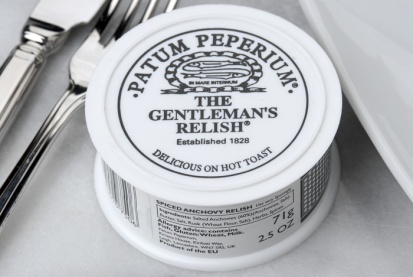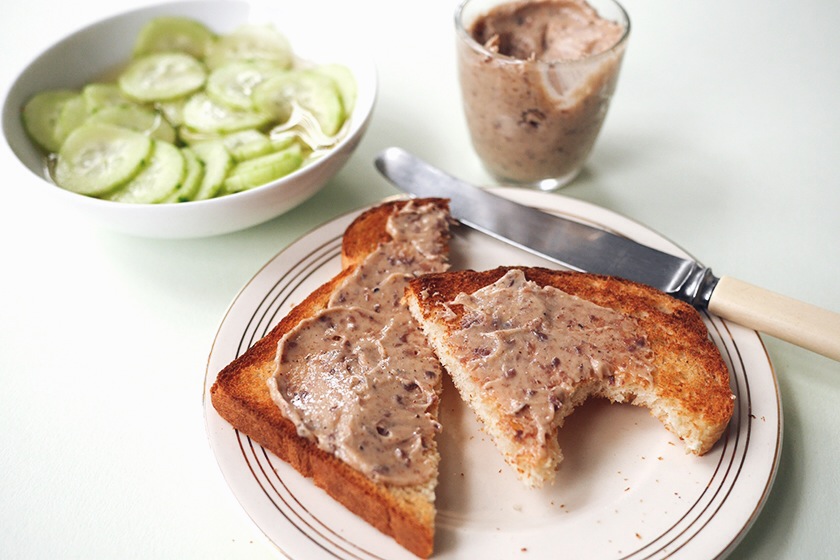A. A. Gill, the English writer and critic observed in his wonderful 2007 book “Table Talk”, “There are many roads to foodie heaven, but, as nanny said, they all have to go down the same big red highway.”
For some years now I have been wandering down the path of stronger flavours in search of my epicurean Elysium. Whether this is my age and my taste buds are wearing out or whether they are bored and just need a bit of a kick to get started I don’t know but I find myself doing things like using six cloves of garlic when the recipe calls for two or three chillies when one would have done in the past. I dream of dishes like tapenade, cheeses like Taleggio, Pont l’Eveque and Stinking Bishop, tom yum soup and even durian… well, perhaps only once with that. Then one evening we had been talking about P. G. Wodehouse, Nancy Mitford or Rumpole or something and I suddenly thought of Patum Peperium, Gentleman’s Relish, that pungent and peppery paste of pure pleasure.
 Perhaps an acquired taste, this relish of anchovies, butter, herbs and spices was first made by an Englishman, John Osborn, in 1828, while he was living in Paris. It was at a time when anchovies in various forms were enjoying great popularity among the Victorians and later the Edwardians, especially the gentlemen.
Perhaps an acquired taste, this relish of anchovies, butter, herbs and spices was first made by an Englishman, John Osborn, in 1828, while he was living in Paris. It was at a time when anchovies in various forms were enjoying great popularity among the Victorians and later the Edwardians, especially the gentlemen.
Originally sold as Patum Peperium, the words “Gentleman’s Relish” were not incorporated into the name until the early 1900’s after being referred to as such so often by those buying it. Traditionally eaten spread sparingly (as instructed on the label) on hot buttered toast with afternoon tea or as an ingredient in the savouries which were the fashionable last course of dinner at the time, it became a great success throughout the then British Empire. Even at breakfast it was popular, Admiral Sir Sydney Smith describing it as “the most delicious breakfast- table accompaniment I have yet tasted.”
Patum Peperium is still made to the original recipe, which remains a secret known only to one person in the company and nowadays it sells in excess of three-quarters of a million pots a year and the demand is growing. It is no longer sold in its old-fashioned porcelain pots, except in the larger sizes, plastic ones having replaced them and is usually available in New Zealand in good delicatessens and department store food halls, generally around Christmas for some reason and at the time of writing costs about $14 for 42.5g pot.
 Of the dishes using the relish, my favourite has to be Scotch Woodcock which, like Colonial Goose, Bombay Duck and Toad in Hole is not at all what it sounds like. Served as a savoury in the Victorian era, it makes a pleasant light lunch or supper. Hot buttered toast is spread with the relish and creamy scrambled eggs are piled on top; it can be garnished with anchovy fillets and parsley. It is also very good spread under the cheese mixture in Welsh rabbit (or “rarebit” as it became in the late 1700s). Another idea that appeals to me is soft boiled egg with relished soldiers.
Of the dishes using the relish, my favourite has to be Scotch Woodcock which, like Colonial Goose, Bombay Duck and Toad in Hole is not at all what it sounds like. Served as a savoury in the Victorian era, it makes a pleasant light lunch or supper. Hot buttered toast is spread with the relish and creamy scrambled eggs are piled on top; it can be garnished with anchovy fillets and parsley. It is also very good spread under the cheese mixture in Welsh rabbit (or “rarebit” as it became in the late 1700s). Another idea that appeals to me is soft boiled egg with relished soldiers.
If you like the sound of this quintessentially English treat and can’t find a shop that sells it or think it too expensive you might like to give this recipe a try, it’s not exactly the same but still works for me…and let’s not be sexist, so…
A Gentleperson’s Relish
 Ingredients:
Ingredients:
- 100g anchovy fillets – drained of oil on paper towel
- 50g salted butter
- 1 tbsp fresh white breadcrumbs
- 1⁄8 tsp cayenne pepper – more or less to taste
- A pinch of each of ground cinnamon, nutmeg, mace and ginger
- Fresh ground black pepper
Method:
Either using a mortar and pestle or the small bowl of a food processor, blend all the ingredients into a smooth, thick paste. Pack the relish into a ramekin or small bowl, cover and store in refrigerator until required.
One note: make sure the spices you use have not been hanging about in the pantry for years as they will have lost all that this recipe requires of them.
Now I’m off to enjoy a pot of tea and eat a crumpet or two…with relish.
By Gerald Bryan
Foodie and cooking specialist









Join the Discussion
Type out your comment here:
You must be logged in to post a comment.